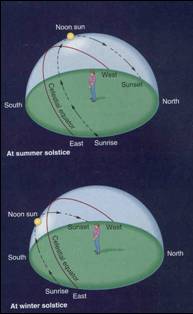Consider
the Sun’s daily motion thru the year
•At the Vernal Equinox Sun is
on the celestial equator.
•At the Autumnal Equinox the
Sun is also on the celestial equator.
•It rises due E, sets due
W
•It is up exactly 12
hours
•At the Summer solstice Sun is
a “northern” star.
•It rises N of E, sets N of
W
•It is up more than 12
hours
•At the Winter Solstice it is
a “southern” star
•It rises S of E, sets S of
W
•It is up less than 12 hours

Key
point: Consider sun fixed at a given
spot on ecliptic over the period of one day.
(From our Text: Horizons, by Seeds)